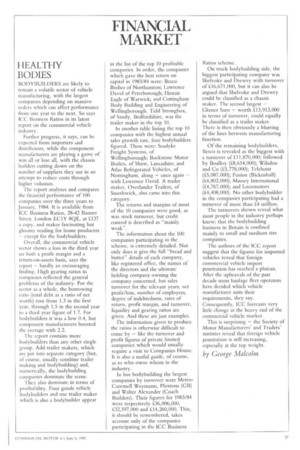HEALTHY BODIES
Page 59

If you've noticed an error in this article please click here to report it so we can fix it.
BODYBUILDERS are likely to remain a volatile sector of vehicle manufacturing, with the largest companies depending on massive orders which can affect performance from one year to the next. So says ICC Business Ratios in its latest report on the commercial vehicle industry.
Further progress, it says, can be expected from importers and distributors, while the component manufacturers are playing a game of win all or lose all, with the chassis builders cutting down on the number of suppliers they use in an attempt to reduce costs through higher volumes.
The report analyses and compares the financial performance of 100 companies over the three years to January. 1984. It is available from ICC Business Ratios, 28-42 Banner Street, London EClY 8QE, at £137 a copy, and makes fascinating but gloomy reading for home producers — except for the bodybuilders.
Overall, the commercial vehicle sector shows a loss in the third year on both a profit margin and a return-on-assets basis, says the report — hardly an encouraging finding. High gearing ratios in companies reflected the general problems of the industry. For the sector as a whole, the borrowing ratio (total debt as a ratio of net worth) rose from 1.3 in the first year, through 1.5 in the second year to a third year figure of 1.7. For bodybuilders it was a low 0.4, but component manufacturers boosted the average with 2.2.
The report contains more bodybuilders than any other single group. Add trailer makers, which are put into separate category (but, of course, usually combine trailer making and bodybuilding) and, numerically, the bodybuilding companies dominate the scene.
They also dominate in terms of profitability. Four goods vehicle bodybuilders and one trailer maker which is also a bodybuilder appear in the list of the top 10 profitable companies. In order, the companies which gave the best return on capital in 1983/84 were: Besco Bodies of Northamton; Lawrence David of Peterborough; Hestair Eagle of Warwick; and Cottingham Body Building and Engineering of Wellingborough. Tidd Strongbox, of Sandy, Bedfordshire, was the trailer maker in the top 10.
In another table listing the top 10 companies with the highest annual sales growth rate, four bodybuilders figured. These were: Seadyke Freight Systems, of Wellingborough; Buckstone Motor Bodies, of Shaw, Lancashire; and Atlas Refrigerated Vehicles, of Nottingham, along — once again — with Lawrence David. A trailer maker, Overlander Trailers, of Smethwick, also came into this category.
The returns and margins of most of the 10 companies were good, as was stock turnover, but credit control is described as "mainly weak".
The information about the 100 companies participating in the scheme, is extremely detailed. Not only does it give the full "bread and butter" details of each company, like registered office, the names of the directors and the ultimate holding company owning the company concerned, but sales turnover for the relevant years, net profit/loss, number of employees, degree of indebtedness, rates of return, profit margin, and turnover, liquidity and gearing ratios are given. And these are just examples.
The information given to produce the ratios is otherwise difficult to come by — like the turnover and profit figures of private limited companies which would usually require a visit to Companies House. It is also a useful guide, of course, as to who owns whom in the industry.
In bus bodybuilding the largest companies by turnover were MetroCammell Weymann, Plaxtons (GB) and Walter Alexander (Coach Builders). Their figures for 1983/84 were respectively £36,006,000, £32,597,000 and £14,260,000. This, it should be remembered, takes account only of the companies participating in the ICC Business Ratios scheme.
On truck bodybuilding side, the biggest participating company was Shelvoke and Drewry with turnover of £.16,671,000, but it can also be argued that Shelvoke and Drewry could be classified as a chassis maker. The second largest — Gloster Saro — worth £13,913,000 in terms of turnover, could equally be classified as a trailer maker. There is then obviously a blurring of the lines between manufacturing function.
Of the remaining bodybuilders, Besco is revealed as the biggest with a turnover of £11,870,000; followed by Boalloy (£8,614,000); Wilsdon and Co (£5,778,000); Telehoist (£5,087,000); Fusion (Bickenhall) (£4,802,000); Massey International (£4,767,000); and Locomotors (£4,408,000). No other bodybuilder in the companies participating had a turnover of more than £4 million.
The turnovers shown reveal what most people in the industry perhaps knew; that the bodybuilding business in Britain is confined mainly to small and medium size companies.
The authors of the ICC report suggest that the figures for imported vehicles reveal that foreign commercial vehicle import penetration has reached a plateau. After the upheavals of the past decade most haulage fleet operators have decided which vehicle manufacturer suits their requirements, they say. Consequently, ICC forecasts very little change at the heavy end of the commercial vehicle market.
This is surprising — the Society of Motor Manufacturers' and Traders' statistics reveal that foreign vehicle penetration is still increasing, especially at the top weight.
by George Malcolm




































































































